Soviet Trucks & military vehicles (1920-45)
 About 3 million built
About 3 million built
During World War II, the Soviet Union used a variety of trucks for military purposes, both domestically produced and imported from other countries. Here are some examples:
GAZ-AA: This was a Soviet truck produced by the GAZ factory between 1932 and 1942. It was used extensively during World War II as a cargo truck and as a platform for artillery pieces.
ZIS-5: This was another Soviet truck produced during World War II. It was used for various purposes, including as a cargo truck, as a platform for artillery, and as a troop carrier.
Studebaker US6: This was an American-made truck that was supplied to the Soviet Union under the Lend-Lease program. It was used as a cargo truck, as well as for towing artillery and as a troop carrier.
GMC CCKW: This was another American-made truck supplied under Lend-Lease. It was used primarily as a cargo truck, but also for towing artillery and as a troop carrier.
GAZ-MM: This was a Soviet truck produced between 1941 and 1948. It was similar to the GAZ-AA, but with a more powerful engine and improved suspension. It was used as a cargo truck, as well as for towing artillery and as a troop carrier. Overall, Soviet trucks played a crucial role in the transportation of troops and supplies during World War II, deployed from the Finnish Campaign in the winter 1939 to the Mandchurian campaign in the summer of 1945.
 ZIS-5/projector trucks, Kuybyshev battle parade, 1941
ZIS-5/projector trucks, Kuybyshev battle parade, 1941
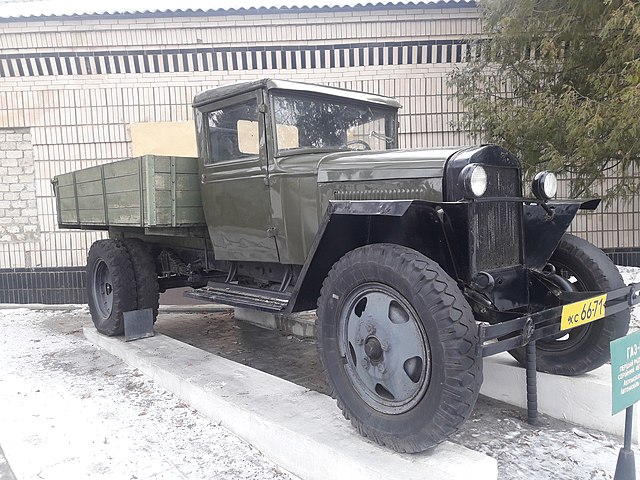 GAZ MM in a museum
GAZ MM in a museum
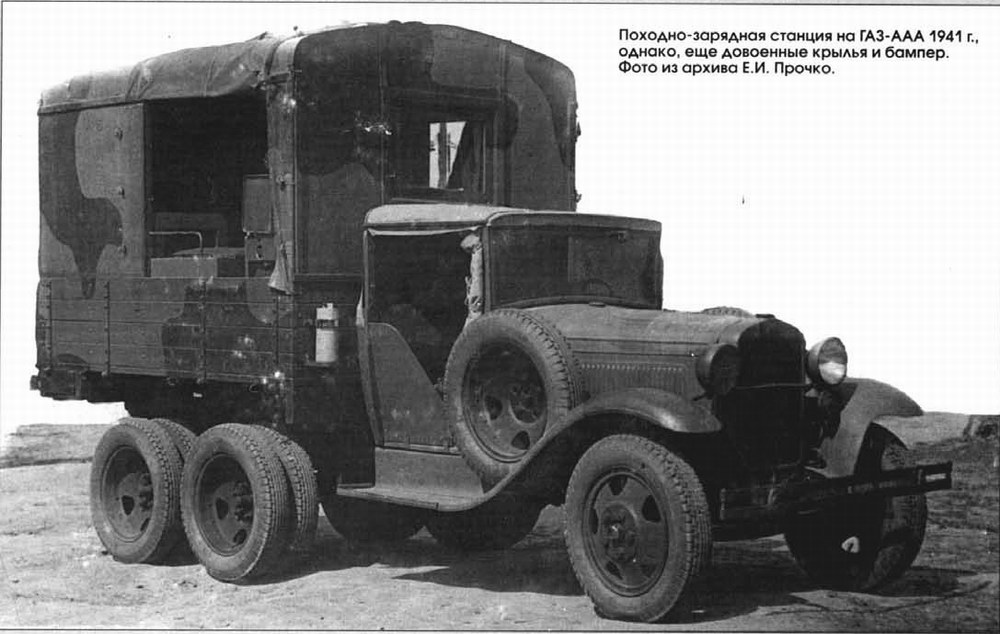 GAZ AA radio station
GAZ AA radio station
 BM-13 Katyusha. These were ZIS-6 truck conversions
BM-13 Katyusha. These were ZIS-6 truck conversions
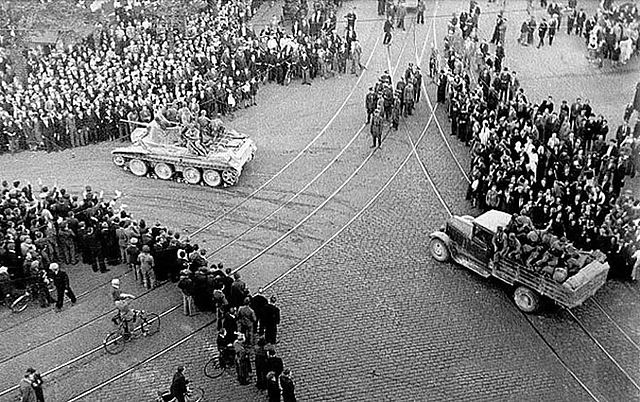 ZIS-5 in Riga, 1940
ZIS-5 in Riga, 1940
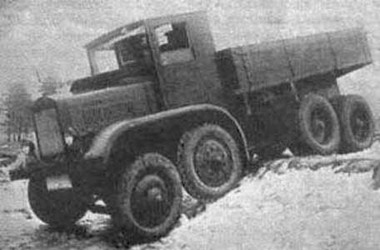 YAG-12 8x8 prototype
YAG-12 8x8 prototype
Staff Cars in Detail
 GAZ A (1930)
GAZ A (1930)

The GAZ-A is a passenger car mass-produced from 1932 to 1936, first passenger car produced in the Soviet Union, near-exact copy of the Ford Model A from 1930. The "Gazik" was popular with the citizens wealthy enough to afford one, and by 1935, 100,000 had been built at GAZ, mostly as light lorries and pickups. The contract between Ford and the Soviet Union was dissolved by mutual agreement and in 1936, production ended after 41,917 cars alone in favor of the improved GAZ-M1. Some were used by the Red Armt as staff cars, but they lacked 4x4 capabilities.
 GAZ TK (1933)
GAZ TK (1933)

In 1933-1934, the GAZ-TK was developed, based on the 4x4 staff car GAZ-A, a Soviet local production of the Ford A. Engineers had to use as much as the GAZ-A as possible to make production of an self propelled gun to assist troops on the move easier. The vehicle was indeed suppose to sport nothing less than a 7,62 mm caliber gun. Not a regular one, as its recoil would have wrecked the chassis's back, but rather a recoiless rifle of the same caliber (3 inches) already in the inventory. The design was approved in 1933, tests were performed with the first prototype in 1934 and by 1935, reconnaissance battalions of the Red Army received the first production GAZ-TK. The gun was locally called "dynamo-reactive" and designed by L.V.Kurchevskiy. Her designed many other experimental recoiless guns ranging from 37 to 305mm, mae by the thousands in the 1930s as they were much lighter than regular guns and can fit on any platform. However the 7.62 mm Kurchevskiy model had so many deficiencies in service that the man was "purged" by Stalin in 1937, ending all further developments.
In order to improve mobility, the GAZ-A staff car was lengthened by one axle, making for a 6x4 lconfiguration, and in its designation, the "T" stands for "triaxal" and the "K" for "Kurchevskiy". But the final vehicle was hurried up and ended globally as a failure. It was underpowered and had a lot of glaring issues, namely on its main gear the gearbox made a “howling” sound that can be heard miles around, the rear brakes jammed on hard terrain, and many other issues meant production was stopped after 23 built, over a few hundred units ordered. The only best featire was its optional caterpillar tracks for the rear train. Only two vehicles allegedly saw action in the winter war against Finland, both lost. The remaining 21 were probably scrapped in short order a few years later... Refs
1 2
Specs GAZ-TK
Dimensions: 4,40 x 1,70 x 1,60 m, ground clearance 21 cm, wheelbase 2,62 +0.86 m.
Curb weight 1,5 tons. GAZ 4 cyl. gas. 3.285 liters 40 hp @ 2200 rpm GBx 4+1 speeds
Turning radius 6,50 m. Fuel tank 78 liters, range c200 km, top speed 63 km/h.
 GAZ M1 (1936)
GAZ M1 (1936)

The GAZ M1 or ”Emka” was a uccessor, modern, all metal and fully enclosed passenger built from 1936 and 1943, at the Gorky plant (now Nizhny Novgorod). Main production ended in 1941, assembling from the existing parts inventory lasted until until 1943 for a total of 62,888 GAZ M1. It was already used as staff car despite its off-road capabilities, and in World War II most Emkas, were requisitioned to be used as staff cars. Its chassis was also declined into armoured variants such as the FAI and BA-20. There were many prototypes. One was refitted with a V8 Ford, only used by thr NKVD as pursuit vehicle. Another, the GAZ-NATI-VM (1937) was tested as a half-track.
 GAZ 61-73 (1941)
GAZ 61-73 (1941)

The purely army 4x4 variant. It had a higher stance and all-wheel drive and could climb angles up to 38 degrees cross water up to 72 cm (28 in) deep. Only 238 were made at Gorky, Ulyanovsk until 1945. They were privileged staff cars reserved for the frontline, Five-seat, four-door phaeton with a 3.4 L GAZ engine rated for 85 hp (63 kW) and able to reach 100 kph.
 GAZ-64 (1942)
GAZ-64 (1942)

The GAZ-61 seemed like a promising vehicle, but the hull was too heavy on its 4x4 chassis and a new design was inspired by the recentl arrived lend-lease US Jeep, as an open-topped, much simpler vehicle. The GAZ-64 was designed by Vitaliy Grachev exceptionally quickly in a few weeks. It had a curb weigh of 1,200 kg (2,646 lb) wile being powered by a beefier 3285 cc inline-4 engine rated for 50 hp (37 kW) for a top speed of 100 km/h (62 mph) but in general it accelerated faster and had better off-road performances compared to the GAZ-61.
It was produced using existing commercially available parts to a total of 646 vehicles until 1942. The secret was a shortened GAZ-61 chassis combined with the GAZ-MM truck egine. Still, many improvements could be done, leading to the next GAZ-67.
 GAZ-67 (1942)
GAZ-67 (1942)

The GAZ-67 is a Soviet off-road military vehicle that was developed during World War II. It's often considered the Soviet counterpart to the American Jeep Willys MB, though it has its own distinct design and characteristics. This really was the "Soviet Jeep". GAZ (Gorkovsky Avtomobilny Zavod) produced them from 1943 to 1953 to a staggering 92,843 produced.
It was powered by a 4-cyl. 3.3 L (3285 cc) gasoline engine, same as GAZ-M1 rated for c54 hp and capable of a top speed of approx. 90 km/h (56 mph). It had a 4-speed manual transmission and the same open body with canvas top for 4 passengers plus a light cargo as its predecessor. It was used for reconnaissance and troop transport more than as staff car.
There were improvements in chassis strength, wheelbase, and performance compared to the GAZ-64. It was simple, rugged and optimized for ease of production and repair woth wider track and reinforced frame compared to the GAZ-64 but lacked creature comforts, focusing entirely on functionality in rough terrain. It's popular among vintage military vehicle collectors today ad its successor, the GAZ-69, became even more widely used across Eastern Bloc nations.
WW2 Soviet Trucks in Detail
 GAZ AA (1931)
GAZ AA (1931)

The GAZ-AA was one of the most iconic and widely used Soviet trucks of the 20th century, particularly during the 1930s and World War II. It was essentially a licensed copy of the Ford Model AA and served as the Soviet Union’s primary light-duty truck during the early stages of industrialization and war. It was produced 1932–1950, originally from the Ford Model AA with a 4x2 (rear-wheel drive) layout, and a 4-cylinder, 3.3 L gasoline engine (GAZ-M1 type) engine, for c40 hp, 70–75 km/h (43–47 mph) and a payload of c1.5 tons. A million were built, sources are unclear about a precise number.
 GAZ BZ-38 (1936)
GAZ BZ-38 (1936)

The BZ-38 was essentially a modified GAZ-AA truck fitted with a cylindrical fuel tank and pumping equipment. It could transport and dispense gasoline or aviation fuel to front-line units and airfields. Some versions were based on the GAZ-MM chassis, which had a more powerful engine and could carry slightly more weight. Widely used during WWII by the Red Army, especially for supporting armored and air units.
The BZ-38 was often seen in logistical convoys, ensuring mechanized units had the fuel needed for operations. Although vulnerable due to the flammability of its cargo, it was indispensable for mobile warfare. BZ-38 original was based on the GAZ-AA truck but the BZ-38U was a later variant with improved tank and pump, sometimes on the upgraded GAZ-MM chassis. There were also similar refueling vehicles built on ZIS-5 and ZIS-6 platforms such as the BZ-39 and BZ-40 for heavier loads.
 GAZ-MM (1941)
GAZ-MM (1941)
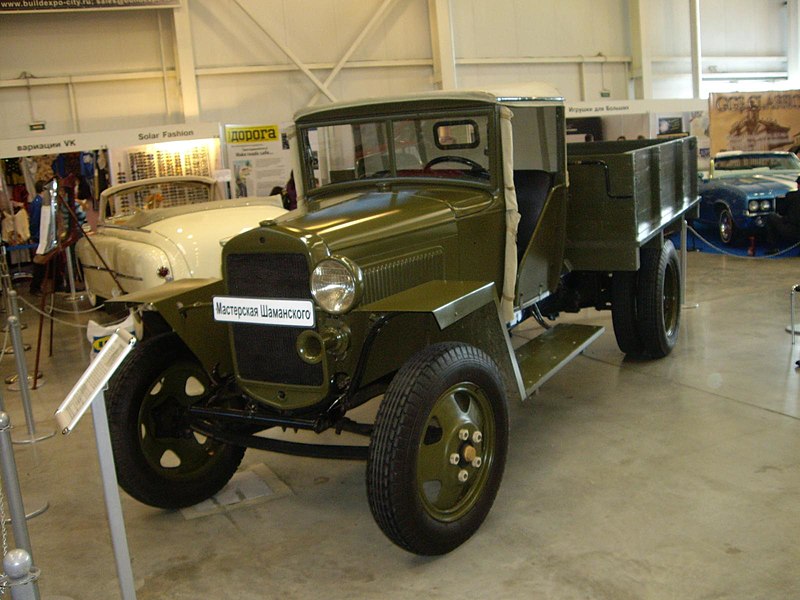
The GAZ-MM was an improved version of the earlier GAZ-AA truck, one of the primary Soviet military triuck in WW2, retained much of the basic design of the GAZ-AA but featuring a more powerful engine and other mechanical upgrades.
Produced from 1938 to 1956 this 4x2 was powered by the new GAZ-M1 inline 4-cylinder, 3.3 L rated for 50 hp nad capable of 80 km/h (50 mph) light on road, for the same capacity at 1.5 tons. It had also a reinforced frame and suspension, better suited for military use, improved brakes and minor enhancements to the cab and controls. It was still hoeve using the same wooden flatbed, two-seat cab, with leaf spring suspension.
Later apeared the simplifed GAZ-MM-V with a simplified wartime version, Lacking front brakes with a wooden cabin and components to conserve metal. The vehicle was aslo fuel tankers, the BZ-38, an Ambulance and radio trucks as well as mobile workshops. 150,000 GAZ MM were manufactured.
 GAZ AAA (1934)
GAZ AAA (1934)

The GAZ-AAA was a three-axle (6x4) Soviet truck, based on the earlier GAZ-AA, developed to handle heavier loads and the chassis to be used for a broader range of military and industrial roles. It was derived from the Ford Model AA or Model BB and adapted to Soviet needs. Produced from 1934 to 1943 it had its two rear axles powere by a 3.3 L inline-4 gasoline from the GAZ-M1 rated for 50 hp and capable of 65 km/h (40 mph) with a payload of 2 tons. It was also famous as a prime platform for the Katiusha rocket launcher, but this was one of many variants. It was much more prolific in this arena compared to the ZIL-5 or the GAZ AA. In all, 37,373 were built.
 GAZ-60
GAZ-60

The GAZ-60 was a half-track vehicle produced in the Soviet Union for a two years in 1939-40, which was not utterly successful. Based on the GAZ-AA, its rear wheels replaced with tracks to improve mobility over snow and mud and the tracked assembly was often adapted from foreign designs, like those of Citroën-Kégresse half-tracks. It was developed to support military operations in difficult terrain, particularly in snowy or muddy conditions, where wheeled vehicles struggled. However it was underpowered for its weight and terrain demands, very slow with a limited range, so it was eventually phased out in favor of more advanced and purpose-built tracked or all-wheel-drive vehicles, such as ZIS-42 and Lend-Lease M3 half tracks.
 GAZ-65 1½-ton Halftrack
GAZ-65 1½-ton Halftrack

The GAZ-65 was a Soviet 1½-ton halftrack prototype, developed in the 1930s as part of efforts to improve cross-country military transport capabilities. It was a 1.5-ton half-track truck which remained a prototype wih a track System similar in concept to Citroën-Kégresse and GAZ-MM petrol engine 50 hp. It had better off-road performance than the standard GAZ-AA or GAZ-MM but suffered from low power-to-weight ratio, mechanical complexity and maintenance challenges. The GAZ-60 had a more sucessful tracked system so only a handly of pre-production models were built.
 YAG-6 (1931)
YAG-6 (1931)

The YaG-6 from Yaroslavsky Avtomobilny Zavod, was one of the rear Heavy truck deployed with the red army. This 4×2 with rear-wheel drive had a payload Capacity of 5 tons and was produced in 1936–1942. It had a Yaz engine 4-cylinder, 93 hp with a 4-speed manual for 50–60 km/h. A large vehicle at 5,300 kg light for 6.9 meters it could be fitted with solid rubber or early balloon-type pneumatic tires and was used to transporting heavy equipment, fuel, and supplies. It was very important for logistics and rear-line duties, until modern Lend-Lease vehicles took over. It became the last with a 4×2 layout before the arrival of 6×6 military vehicles and was replaced notably by the YaAZ-200 post-WWII.
 YAG-10 (1932)
YAG-10 (1932)

Only 333 of these heavy trucks with a payload of 6-8 tonnes were manufactured from 1932 to 1940, powered by a Hercules-YXC engine, with a 4-speed Brown-Lipe-554 manual gearbox and a the rear suspension was based on British Moreland WD Trucks. It had a top speed limited to 42 km/h with a fuel consumption of 60 liters per 100 km and production was terminated in 1940. However, it was declined into the first dedicated truck-based SPAA of the Soviet Army, the 76mm 3-K Model 1931 AA gun (63 converted).
Next: ZIL/ZIS trucks and Tractors.
List of soviet ww2 vehicles
GAZ
-GAZ BZ-38 fuel truck derived from the GAZ AA
-
GAZ AA M1927 M1932 M1941
-
GAZ–MM
-GAZ-A Staff Car (1933)
-
GAZ AAA M1937/M1940
-GAZ-TK SPG (1935)
-GAZ-60 Half-Track Truck
-GAZ-61-73 Staff Car
-GAZ-65 1½-ton Halftrack
-GAZ-67 4x4 Command Car
YAG
-Yag-6 4x2 truck
-Yag-10 6x6 truck
ZIL
-ZIS-5/V/BZ
-ZIS-5 (Izhorsk armored Truck)
-ZIS-6
-ZIS-12
-ZiS-22(M) 2½-ton Halftrack
-ZiS-33 2½-ton Halftrack
-ZIS 41 Halftrack
-ZiS-42(M) 2.5-ton Halftrack
Kégresse
-FN-Kégresse T3
 Soviet Artillery Tractors
Soviet Artillery Tractors
-Komsomolets (4,041 pre-war)
-
T-26-T
-STZ-3 (3,658 pre-war)
-STZ-5 (7,170 pre-war)
-Stalinets (ChTz S-65) (?)
-Komintern (1,017 pre-war)
-Voroshilovets (1228 1942)
-Kommunar (504 pre-war)
-YA-12 (1,666)
-Wheeled Tractor SKhTZ 15-30 (1930)
 Soviet staff cars cars
Soviet staff cars cars
-GAZ 11-73 staff car
-GAZ M-1 "Emka", 4x2, Command Car
-GAZ-55 Ambulance
-GAZ-A Staff Car (1933)
-GAZ-61-73 Staff Car
-GAZ-67 4x4 Command Car
 Amphibious armoured cars
Amphibious armoured cars
-PB-4
-PB-7
-BAD-2